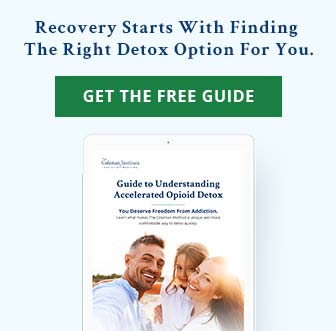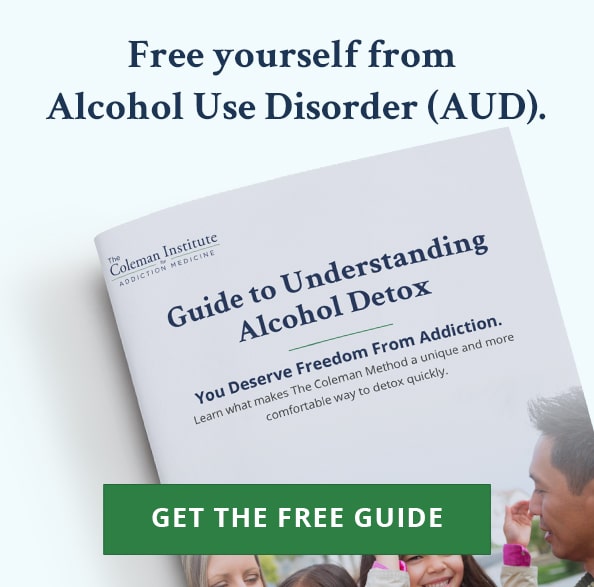The Coleman Institute Blog
3
Jul 25
July 3, 2025
Flumazenil for Benzo Withdrawals – The Coleman Institute’s Outpatient Detox Approach
Benzodiazepines, commonly known as benzos, are medications frequently prescribed to manage anxiety, panic disorders, and sleep issues. Drugs such as Xanax, Ativan, Klonopin, and Valium can be helpful in the short term, but prolonged use can lead to dependence and, for many people, a difficult road when it's time to stop.
If you've tried to reduce or stop your use of benzodiazepines and experienced distressing withdrawal symptoms, you're not alone. We've worked with thousands in similar situations at The Coleman Institute. That's why we developed our Rapid Benzo Detox program, which includes a unique and highly effective component, Flumazenil.
The Coleman Institute is the only provider in the United States offering this Flumazenil-assisted protocol.
This treatment is available exclusively at our Richmond, Virginia, and Denver, Colorado, locations.
Understanding Benzo Withdrawal
People often begin taking benzodiazepines under a doctor's care, with good intentions and a valid need; whether it's to treat anxiety, get sleep under control, or manage symptoms of panic disorder. But over time, the body becomes dependent, and stopping the medication abruptly, or even tapering slowly, can lead to overwhelming withdrawal symptoms.Common benzo withdrawal symptoms include:
- Intense anxiety or panic attacks
- Insomnia or disrupted sleep
- Muscle stiffness, tremors, or spasms
- Light, sound, or touch sensitivity
- Mood swings or irritability
- Poor concentration or brain fog
- Nausea, dizziness, or heart palpitations
What Is Flumazenil & How Does It Help?
Flumazenil is a medication that was originally developed to reverse the effects of benzodiazepines in emergency overdose situations. However, when administered in a slow and controlled way, it has a unique benefit: it can help the brain reset its sensitivity to benzodiazepines.Benzodiazepines act on the brain's GABA receptors, which regulate feelings of calmness, sleepiness, and relaxation. Long-term use of benzos can desensitize these receptors over time.
When you suddenly stop taking the medication, the brain becomes overstimulated, leading to the intense symptoms of withdrawal. Flumazenil helps gently re-regulate these receptors, which can ease the symptoms of withdrawal and shorten the detox process.
The Coleman Institute's Flumazenil-Based Detox Protocol
 At The Coleman Institute, we've developed a structured, medically supervised outpatient program that combines Flumazenil with comfort medications and compassionate care. This approach allows patients to stop benzos quickly and safely, without the need for hospitalization or inpatient rehab.
At The Coleman Institute, we've developed a structured, medically supervised outpatient program that combines Flumazenil with comfort medications and compassionate care. This approach allows patients to stop benzos quickly and safely, without the need for hospitalization or inpatient rehab.
Key benefits of our Rapid Benzo Detox program:
- Detox in as little as 8 days
- Outpatient care with no overnight stay
- Effective Flumazenil infusion protocol
- Daily clinical monitoring & comfort medications
- Compassionate, experienced medical team
- Aftercare planning to support your long-term recovery
You won't find this protocol anywhere else in the country.
Why Choose The Coleman Institute?
Since 1998, The Coleman Institute has helped thousands of patients nationwide detox from substances including opioids, alcohol, benzodiazepines, and more. We're known for our compassionate, evidence-based outpatient programs prioritizing comfort, safety, and effectiveness.Whether you've been taking benzos for a few months or many years, we're here to help you take the next step toward healing, without judgment and with support every step of the way.
Who Is a Good Fit for This Program?
Our Flumazenil-based detox is ideal for people who:- Have been taking benzodiazepines regularly & want to stop
- Tried tapering off benzos in the past without success
- Experienced intense withdrawal symptoms during previous attempts
- Are seeking a discreet, non-residential treatment option
- Want a faster & more comfortable alternative to long-term tapering
What to Expect During Your Detox
Your treatment experience is tailored to your individual needs, but here's what most patients can expect:- Pre-detox medical evaluation to assess health history & current usage
- Daily clinic visits for IV Flumazenil infusions & symptom management
- Comfort medications to reduce physical & emotional distress
- Medical supervision & monitoring throughout the process
- A personalized aftercare plan to promote long-term success
Recovery is Possible & We Can Help
Benzodiazepine dependence can feel isolating, but we're here to help you along your recovery journey. Our unique Flumazenil-assisted outpatient detox program can help you reclaim your life with fewer withdrawal symptoms and a much smoother transition off benzos.We are the only treatment center in the U.S. offering this Flumazenil-assisted outpatient detox protocol.
Call us today at 571-620-5985 to speak with a recovery expert.
19
May 25
May 19, 2025
Suboxone Withdrawals – Understanding the Symptoms
Suboxone (a combination of buprenorphine and naloxone) has helped many people manage opioid addiction and reduce the risk of relapse. But for those who are ready to stop taking Suboxone, the journey forward often begins with a critical question: What happens when I stop?
Suboxone withdrawal is very real, and although generally less intense than other forms of opioid withdrawal (oxycodone, heroin, etc.), it can still be physically and emotionally taxing. If not done properly, it can lead to relapse or prolonged dependence. That's why understanding the withdrawal process and having a medically supervised detox plan is critical.
At The Coleman Institute, we offer a safe, outpatient Suboxone detox program designed to help people stop using the medication safely and comfortably in as little as 8 days.
What Is Suboxone & How Does It Work?
Suboxone is prescribed as part of Medication-Assisted Treatment (MAT) for opioid use disorder.Suboxone contains two ingredients -
- Buprenorphine: A partial opioid agonist that activates opioid receptors to reduce cravings and withdrawal symptoms without producing the full euphoria of other opioids.
- Naloxone: An opioid antagonist added to deter misuse. It remains inactive when taken as directed, but can block opioid effects if the medication is misused intravenously.
Why Does Suboxone Withdrawal Happen?
Even though Suboxone is used to treat opioid dependence, it's still an opioid. Over time, the brain adjusts to its presence. When the medication is reduced too quickly or stopped abruptly, withdrawal symptoms occur as the body struggles to rebalance without it.Factors that can influence the severity of withdrawal include -
- Duration of Suboxone use
- Daily dosage
- Overall physical health
- Co-occurring mental health conditions
- History of opioid use
Suboxone Withdrawal Symptoms - What to Expect
Withdrawal symptoms are similar to those of other opioids but tend to come on more gradually and last longer due to Suboxone's extended-release properties.Physical Symptoms
- Muscle aches & body pain
- Nausea, vomiting, & diarrhea
- Headaches & abdominal cramps
- Excessive sweating or chills
- Fatigue & low energy
- Tremors or restlessness
- Sleep disturbances or insomnia
- Runny nose, watery eyes, or yawning
Psychological Symptoms
- Anxiety or panic attacks
- Depression or emotional numbness
- Mood swings & irritability
- Intense cravings for opioids
- Difficulty concentrating or staying motivated
- Feeling disconnected or overwhelmed
Suboxone Withdrawal Timeline
The timeline for Suboxone withdrawal can vary based on how the medication is stopped. The following is a general overview of what to expect when stopping Suboxone abruptly (cold turkey), without medical tapering -1 - 3 Days After Last Dose:
- Symptoms begin to emerge
- Anxiety, body aches, & insomnia are common
4 - 7 Days:
- Peak withdrawal symptoms
- Strong cravings, nausea, chills, & mood swings
2 - 4 Weeks:
- Physical symptoms begin to improve
- Mental health symptoms like depression & fatigue may persist
1+ Month:
- Some individuals experience Post-Acute Withdrawal Syndrome (PAWS)
- Ongoing psychological symptoms like low mood, poor sleep, & cravings may linger
Is It Safe to Detox from Suboxone at Home?
Tapering off Suboxone without medical supervision can be physically uncomfortable and emotionally overwhelming. Unfortunately, many people who attempt to quit cold turkey or without guidance end up relapsing or prolonging the process.Home detox attempts may lead to -
- Unmanaged withdrawal symptoms
- Risk of turning to other opioids
- Sleep deprivation and emotional instability
- Dangerously high relapse risk
Outpatient Suboxone Detox at The Coleman Institute
The Coleman Institute offers an accelerated Suboxone detox program that can help most patients completely detox in as little as 8 days, all without the need for hospitalization.What Makes Our Program Different?
- Outpatient-based care: Receive treatment while staying in the comfort of your own home or nearby accommodations
- Non-addictive comfort medications: Minimize withdrawal symptoms without using other opioids
- Naltrexone therapy: Helps reduce cravings after detox and supports long-term recovery
- Personalized care: Each detox is personalized to the individual's unique medical and substance use history
- Aftercare coordination: We work with patients to plan next steps in therapy, support groups, and relapse prevention
What Happens After Suboxone Detox?
Completing detox is a major milestone, but it's not the journey's end. Recovery is an ongoing process that requires continued support.After detox, individuals often benefit from -
- Outpatient counseling or therapy
- Peer support groups (like SMART Recovery or NA)
- Dual-diagnosis treatment if co-occurring conditions are present
- Recovery coaching or case management services
Take the First Step Toward Life After Suboxone
Suboxone withdrawal can be extremely difficult, but we're here to help you get through it as comfortably and safely as possible. The Coleman Institute offers a compassionate, medically supervised detox program that's fast, safe, and designed around your needs.If you're ready to stop Suboxone and move forward in your recovery, our experienced team is here to guide you toward lasting healing. Call The Coleman Institute at 703-991-0330 or schedule a callback to learn more about our safe, comfortable, and effective detox services.
6
May 25
May 6, 2025
Is The Coleman Institute Open? Why We Closed Briefly & What’s Ahead
If you've recently searched "Is The Coleman Institute open?" or "Why did the Coleman Institute close?", we're here to provide a clear and up-to-date overview of where we've been and where we're going.
A Legacy of Compassionate Detox Care Since 1998
Founded in 1998 by Dr. Peter Coleman, the Coleman Institute has helped thousands of individuals safely detox from opioids, alcohol, and other substances. With a focus on outpatient medical detox protocols, we have long been recognized for our effective, comfortable approach to recovery.In 2017, The Coleman Institute joined BayMark Health Services, working collaboratively with Applegate Recovery. This partnership helped us provide evidence-based detox services as part of a larger behavioral healthcare network.
Why Did the Coleman Institute Close?
In late 2024, the Coleman Institute experienced a brief pause in operations during a leadership transition and organizational restructuring. This temporary closure allowed for internal updates and a thoughtful transition to independent ownership, ensuring continued alignment with our long-standing mission and values.Reopening Under New Independent Leadership
As of 2025, the Coleman Institute has reopened as an independently operated organization, now led by Jennifer Gifford. Jennifer has been a part of the Coleman team since 2000 and now serves as CEO and owner. Her leadership reflects decades of experience and a deep commitment to the values that have defined Coleman since its founding.Is the Coleman Institute Open Now?
Yes, the Coleman Institute is currently open and actively serving patients at our Richmond, Virginia, headquarters.Additional Locations Reopening
We are also working to reopen several affiliate locations across the country in the near future, including:- Denver, Colorado (Aurora) - Target reopening date in late May 2025
- Atlanta, Georgia (Dawsonville) - Target reopening date in late May 2025
- Tampa, Florida (Largo) - Target reopening date in early June 2025
- Orange County, California (Santa Ana)
- San Francisco, California (Burlingame)
21
Apr 25
April 21, 2025
Tianeptine Powder Explained – Safety Concerns, Addiction Risks, & Withdrawal
Tianeptine powder has drawn attention in recent years, though not for positive reasons. Marketed under brand names like Stablon in other countries, tianeptine was originally developed as a prescription antidepressant. These pharmaceutical versions are typically produced as tablets, not powders. However, in the United States, tianeptine is often sold in unregulated forms, including powder and liquid, under street names like ‘zaza’ or ‘gas station heroin’. This growing misuse has raised serious concerns about safety, addiction potential, and withdrawal risks.
What Is Tianeptine Powder?
Tianeptine is a synthetic drug that was originally prescribed to treat major depressive disorder. Unlike traditional antidepressants, tianeptine works primarily by modulating glutamate activity and, more importantly, by acting as a mu-opioid receptor agonist. This opioid receptor activity is key to understanding why misuse can quickly spiral into dependence.Tianeptine is now available through unregulated markets in several forms, including powder, capsules, and liquids. However, tianeptine powder, particularly in the sodium form, poses unique risks because it is pure, highly potent, and difficult to measure dosages due to its consistency.
Pharmaceutical versions such as Stablon, Tatinol, and Coaxil are provided by medical professionals in tablet form in other countries. In the United States, powdered versions are often bought online or at various retailers, including gas stations.
How Tianeptine Powder Became a ‘Gas Station Heroin’
Sold under flashy names like ‘zaza’, tianeptine is often marketed as a supplement or nootropic. In reality, its opioid-like effects can lead to euphoria, sedation, as well as physical and psychological dependence, much like traditional opioids such as morphine. Because it acts directly on opioid receptors, users may initially feel mood elevation or pain relief, but with repeated use, tolerance builds rapidly, setting the stage for addiction.The nickname 'gas station heroin' illustrates how potent and dangerous tianeptine powder can be, while remaining accessible through shops.
Is Tianeptine Powder Similar to Kratom?
In some ways, yes. Both tianeptine and kratom affect the brain's mu-opioid receptors, producing effects like euphoria and sedation. However, while kratom is derived from a plant (Mitragyna speciosa) and contains multiple alkaloids, tianeptine is a synthetic compound. Many users seeking alternatives to prescription opioids may turn to substances like kratom or tianeptine, believing them to be safer options. Unfortunately, both can lead to dependence, withdrawal, and the need for professional detox services.Addiction & Withdrawal Risks
Because tianeptine interacts so powerfully with opioid receptors, it carries a high risk of misuse, especially for those already struggling with addiction. Symptoms of tianeptine dependence and withdrawal can mirror those of traditional opioid withdrawal.Symptoms may include -
- Anxiety & panic attacks
- Muscle aches & cramps
- Insomnia
- Nausea & vomiting
- Depression & mood swings
How The Coleman Institute Can Help
At The Coleman Institute, we specialize in outpatient detox services designed for substances, including those that impact the brain's opioid receptors, such as tianeptine. Our Outpatient Opioid Detox program helps patients safely and comfortably manage withdrawal symptoms without the need for lengthy inpatient stays. We understand the unique challenges that come with tianeptine dependence, and we provide compassionate, medically supervised care to promote long-term recovery.If you or a loved one is struggling with tianeptine use, help is available. Call The Coleman Institute at 703-991-0330 or schedule a callback to learn more about our safe, comfortable, and effective detox services.
15
Apr 25
April 15, 2025
Kratom Dependence – Why This ‘Natural Remedy’ is Dangerous
In recent years, kratom has gained a reputation as a so-called ‘natural remedy’ for pain, anxiety, and even opioid withdrawal. Available in smoke shops, gas stations, and online, it is marketed as a legal herbal alternative to prescription medications. But as kratom use becomes more widespread, so do the stories of individuals developing kratom dependence, struggling with painful withdrawal symptoms, and needing help stopping.
At The Coleman Institute, we are seeing firsthand how kratom can negatively impact people. Many are surprised by how addictive it has become for them despite its natural origins. Our Outpatient Kratom Detox Program helps those struggling safely, comfortably, and quickly detox from kratom.
What Is Kratom?
Kratom (Mitragyna speciosa) is a tropical tree native to Southeast Asia, with leaves that contain compounds called mitragynine and 7-hydroxymitragynine. These compounds interact with opioid receptors in the brain, producing effects similar to opioids, such as euphoria, pain relief, and sedation, especially at higher doses.Some users take kratom for its stimulant-like effects at low doses or to manage chronic pain, while others use it as a 'DIY remedy' for opioid withdrawal. However, regular use can lead to tolerance, physical dependence, and withdrawal symptoms similar to those experienced with other opioids.
Is Kratom Addictive?
Despite being unregulated at the federal level in the United States, kratom carries a very real risk of addiction. Continuous use leads to both physical and psychological dependence.Individuals who try to stop using kratom can experience withdrawal symptoms such as:
- Intense cravings
- Anxiety & irritability
- Mood swings & depression
- Insomnia
- Muscle aches
- Runny nose & watery eyes
- Nausea, vomiting, & diarrhea
The Rise in Kratom Use and Its Consequences
Many perceive kratom as a ‘safe’ or ‘natural’ alternative to opioids, but this perception is dangerously misleading. According to the FDA, there is growing evidence that kratom can cause addiction, seizures, liver damage, and even death in some cases. Emergency room visits and poison control calls related to kratom have also increased in recent years. Many find it difficult or even impossible to stop due to the severity of the withdrawal symptoms. That’s when kratom detox becomes necessary.The Coleman Institute’s Kratom Detox Program
At The Coleman Institute, we offer an Outpatient Kratom Detox Program that helps people quit kratom quickly and safely without the need for an inpatient stay or overnight hospitalization.Why Choose Our Kratom Detox?
- Outpatient Setting – Detox in the comfort of a non-hospital environment for five days.
- Comfort Meds to Help Minimize Withdrawal Symptoms - Customized medications throughout the detox that greatly reduce patient discomfort.
- Compassionate, Personalized Care – Our experienced medical team provides continuous monitoring, emotional support, and a tailored treatment plan.
- Aftercare Planning & Relapse Prevention – Detox is only the first step. We help you develop a long-term recovery strategy to maintain sobriety and avoid relapse.
- Break the Cycle – Many of our patients have already tried to quit kratom on their own, sometimes multiple times, without success. At the Coleman Institute, people stuck in the cycle of dependence finally have a safe, proven way to move forward.
Who Should Consider Kratom Detox?
You may benefit from our kratom detox program if:- You’re using kratom daily or multiple times per week
- You feel like you need kratom just to get through the day
- You’ve experienced withdrawal symptoms when trying to quit
- You’ve tried to quit before but couldn’t
- You want a safe, medically supervised way to start fresh
It’s Time to Break Free from Kratom Dependence
If you or someone you love is struggling with kratom addiction, don’t wait for the situation to worsen. Kratom may be legal, but that doesn’t equate to being harmless. As dependence grows, so do the risks to your mental and physical health.At The Coleman Institute, we’ve helped thousands of people safely detox over the last 25 years from addictive substances, including kratom, with a 98% completion rate. Our compassionate team is here to help you achieve lasting recovery.
Learn more about our Kratom Detox Program by visiting our webpage!
Call us at 703-991-0330 to speak with a recovery specialist or schedule a callback.








